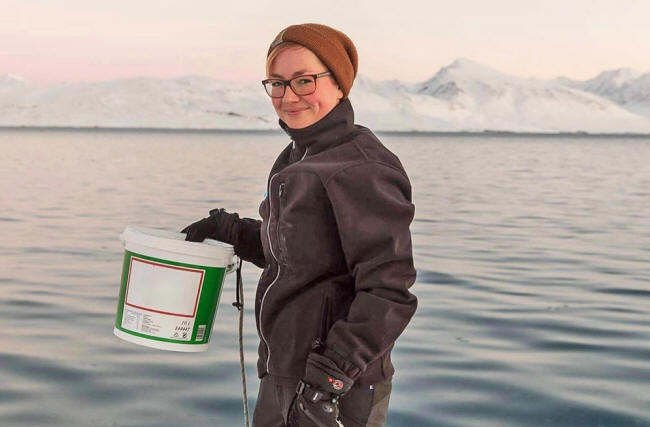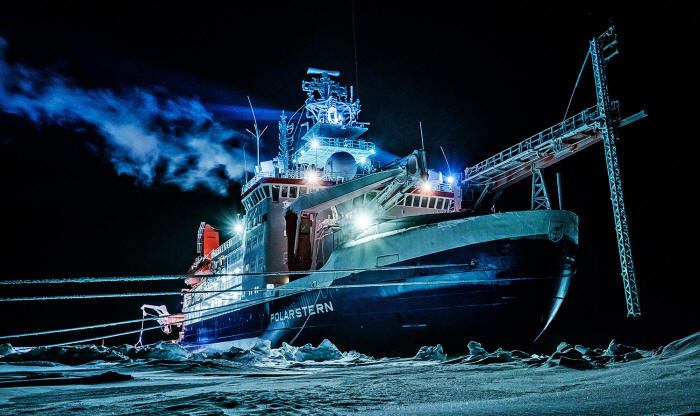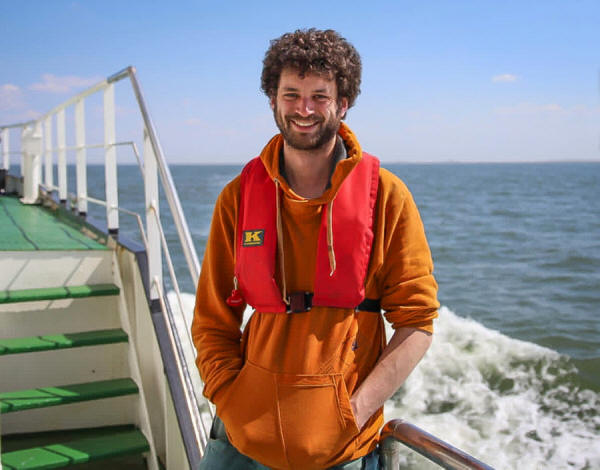|
from
QuantaMagazine Website
Video: Click Image Under the ice, as the first photons of spring sunlight penetrated the Arctic's dark polar night, researchers measured algal cells harvesting light at the theoretical minimum of photosynthesis, less than one-hundred-thousandth
of the light of
a sunny day. during the Arctic's pitch-black polar night, cells power photosynthesis on the lowest light levels ever observed in nature...
On a bright, sunny day, there's a wealth of photons to go around.
But what happens at low light?
Biologists have long been curious about just how little light photosynthesis can run on - or how many photons need to arrive, and how quickly, for a cell's photosynthetic machinery to process carbon dioxide into oxygen and energy.
Calculations have suggested a theoretical minimum
of around 0.01 micromoles of photons per square meter per second, or
less than one-hundred-thousandth of the light of a sunny day.
No one could confirm it in the field, though there are plenty of places on Earth that light barely reaches. Every winter in the high Arctic, for example, the sun, hidden by the tilt of the Earth, vanishes for months.
Meters of snow blanket the sea ice and block incoming light, leaving the frigid ocean below as dark as the inside of a tomb.
There, biologists assumed, photosynthesizing microalgae that live in the water and ice power down for the season and wait for warmth and light to return.
Clara Hoppe, a biogeochemist at the Alfred Wegener Institute, probed the limits of photosynthesis in the
months-long darkness
of the Arctic polar night.
In winter 2020, Hoppe spent months living on a ship wedged into an ice floe, through the polar night, to study the limits of photosynthesis in the dark.
Her team's recent study in Nature Communications (Photosynthetic Light Requirement - Near the theoretical minimum detected in Arctic microalgae) reported microalgae growing and reproducing at light levels at or close to the theoretical minimum - far lower than had previously been observed in nature.
The study shows that in some of the coldest, darkest places on Earth, life blooms with the barest quantum of light.
The Power of the Dark Side
Scientists have traditionally understood the Arctic to be a place of stasis for much of the year.
It seemed to Hoppe that any phytoplankton able to get an earlier start than the competition could have a more successful summer.
This led her to wonder,
Her interest received a jolt in 2015 when she tagged along on a research project led by researchers at the University of Troms° in Norway.
The multidisciplinary team found an unexpectedly thriving ecosystem in the winter waters off the Svalbard archipelago; some organisms, particularly clams, were actually more active than they were in summer.
To everyone's surprise, the phytoplankton were not asleep either:
Rather than sinking into surface sediments and overwintering in a dormant "sleep mode," many cells Hoppe found were having an active winter, with their cellular operations fully up and running.
She began to wonder about the vast, cold blackness of the polar ocean...
The icebreaker ship RV Polarstern wedged itself into an ice floe in fall 2019, then turned its engines off. For months it drifted with the sea ice and served as a base for scientists studying the physics, chemistry and biology
of the Arctic's polar
night. Lukas Piotrowski
In early 2020, Hoppe found herself testing the limits of photosynthesis directly, camped aboard an icebreaker ship that had been deliberately rammed into an ice floe and allowed to drift with its engines off through the polar night.
A rotating crew of scientists with the expedition Mosaic (Multidisciplinary Drifting Observatory for the Study of Arctic Climate) occupied RV Polarstern on its journey to gather as much data about the Arctic winter as possible.
Hoppe and her colleagues worked in the darkness of 24-hour night, amid expanses of glittering ice and wind chills down to -76║F (-60║C).
Cracks and ridges in the ice constantly shifted the route to a permanent hole in the ice, named Ocean City, from which Hoppe and her team gathered hundreds of liters of seawater samples and hauled them back to the ship for analysis.
The team carried out two parallel sets of measurements.
By measuring the cells' carbon-uptake rates, they were able to estimate the limits of the organisms' capacity for photosynthesis.
By the end of March, however, the microalgae's carbon uptake had jumped, along with the number of cells and the concentration of chlorophyll - proxies for growth and photosynthesis.
Hoppe and her team,
At Ocean City (left), a scientific encampment on the ice floe, researchers collected seawater from a permanent hole in the ice (right). The sampled region changed
as the floe drifted
across the Arctic. Right: Alfred Wegener Institute/Michael Gutsche
Yet a key piece of evidence only emerged three years after the expedition, Hoppe said, and from researchers in another department: the physicists measuring light beneath the sea ice.
This has historically been tricky:
To get around the problem, the sea ice physicist Niels Fuchs and his team aboard RV Polarstern had placed extremely precise light sensors around the ice floe early in the season and allowed them to freeze to the underside of the ice for the winter.
Like trail cameras placed in the backwoods by a wildlife biologist, the light sensors recorded data on under-ice light for months, undisturbed.
In February, the darkness of the polar night was nearly absolute, and not even photons from a bright moon or fleeting twilight could reach the dark waters below.
Then, in late March, the sun briefly surfaced over the horizon.
Beneath that ice, the light sensors recorded an astronomically small number of photons:
The actual amount of light was probably lower.
To measure the amount of light penetrating the sea ice, the physicist Niels Fuchs froze light sensors into the ice floe
and left them to
record data undisturbed for months.
Their estimate is a conservative one, he added, and it's possible even fewer photons got through.
Because some parts of the sheet might allow more light through than others, the research team selected the upper thresholds of their light measurements.
Pairing Fuchs' light data with Hoppe's microalgae observations clinched it:
Her team concluded that they'd made the first-ever field observation of photosynthesis at just around the theoretical minimum - where the amount of light was an order of magnitude lower than what had been observed in nature before.
Sleep No More
Hoppe was excited to observe photosynthesis at or near the minimum amount of light that could power life.
But the finding raised a question:
Her team found that during the darkest periods of polar night, the microalgae didn't show a measurable uptick in carbon uptake - they were neither growing nor photosynthesizing.
Then, as soon as the light levels rose enough to support active carbon fixation in late March, the algae were ready to explode into action.
The researchers aren't entirely sure how the microalgae managed to stay alive and out of dormancy through the darkest times. Some, such as diatoms, can consume dissolved organic nutrients directly from the water.
Perhaps they could eke out a living from stray photons that passed through cracks in the ice or were emitted by some bioluminescent creature.
Or perhaps polar algae have evolved unique mechanisms that can keep their metabolism running on low at frigid temperatures so that they're ready to activate at first light.
Such adaptations might be important to the ecology of the region, said Kevin Flynn, a plankton specialist at Plymouth Marine Laboratory who was not involved in the study.
However, he isn't entirely convinced that the cells' late-March growth occurred through photosynthesis.
On the other hand, Campbell thinks it's possible that the algae might be photosynthesizing even earlier than Hoppe's team suggested.
Their estimates of light levels were conservative, he said, and photosynthesis may have been occurring well in advance of the kind of biomass accumulation that's easy to measure.
It is feasible to him, then,
The findings paint a new picture of life in the Arctic's polar night and possibly beyond.
Life may not be packed entirely into a few short months of summer; rather, the waters may be productive - or, at the very least, still living - throughout the year.
This, Hoppe said,
She wonders, too, whether Arctic phytoplankton's ability to ride out near-absolute darkness might be shared by some algae in the colder, darker waters of the deep sea.
If she's right, the zone of productive ocean may be deeper than anyone thought.
|





